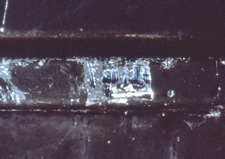Home | Glossary | Resources | Help | Contact Us | Course Map
Archival Notice
This is an archive page that is no longer being updated. It may contain outdated information and links may no longer function as originally intended.
Toolmark Examination
Toolmark identification is the microscopic comparison and potential identification of striated or impressed toolmarks as having been made by the same tool.
The foundation for this technique is based on the following principles:
- A tool will bear unique microscopic characteristics due to the manufacturing processes it undergoes, as well as through use and abuse.
- Tools will generally mark surfaces with which they come in contact with class and individual characteristics.
- These class and individual characteristics are typically reproducible and identifiable with a particular tool.
Examiners should be aware and take into account the potential for the presence of subclass characteristics.
Toolmark comparison and identification are typically performed on the following types of evidence:
- Test marks from an evidence tool compared to toolmarks on evidence items recovered from a crime scene to determine if the evidence tool marked the evidence item
- Evidence toolmarks recovered from multiple crime scenes to determine if the scenes are related to a single tool
Additional Online Courses
- What Every First Responding Officer Should Know About DNA Evidence
- Collecting DNA Evidence at Property Crime Scenes
- DNA – A Prosecutor’s Practice Notebook
- Crime Scene and DNA Basics
- Laboratory Safety Programs
- DNA Amplification
- Population Genetics and Statistics
- Non-STR DNA Markers: SNPs, Y-STRs, LCN and mtDNA
- Firearms Examiner Training
- Forensic DNA Education for Law Enforcement Decisionmakers
- What Every Investigator and Evidence Technician Should Know About DNA Evidence
- Principles of Forensic DNA for Officers of the Court
- Law 101: Legal Guide for the Forensic Expert
- Laboratory Orientation and Testing of Body Fluids and Tissues
- DNA Extraction and Quantitation
- STR Data Analysis and Interpretation
- Communication Skills, Report Writing, and Courtroom Testimony
- Español for Law Enforcement
- Amplified DNA Product Separation for Forensic Analysts



